Use Google Analytics To Treat Your Account Holders Like Royalty
Columnist Brian Massey reminds us that visitors who have created an account on your site are some of your most valuable prospects. Are you treating them as such?

There are a number of segments that require special attention when we are implementing our analytics solutions. One of the most interesting will be “Account Holders.”
It doesn’t matter if we run an ecommerce site, a subscription site, a blog, or an online service. Account holders are to be coddled and loved. Account Holders should be encouraged walk around your site in their socks on the plush red carpet you’ve provided for them. They should get medals for just being themselves.
MailChimp gives account holders high-fives when they accomplish something on the site.

MailChimp rewards account holders with high-fives.
On The Conversion Scientist blog, we give subscribers to our free course badges when they read our content. And if they achieve Ph.D. status, we give them a free website review. Ecommerce sites offer account holders discounts and exclusive coupons.

Account holders on your blog can be rewarded for reading.
Why spoil Account Holders that may never have bought anything from you? Because, they have shown a commitment to your website and, by association, your organization beyond that of the average schmoe. They have established a room at your inn, a place in line and a row in your database.
They have exhibited championship-level buying intent. They have given you notice that they have developed some trust for you.
Let’s not let them down.
Make Sure Account Holders Are Comfortable On Your Site
We tend to lump our account holders in with our other visitors in our analytics setups. They’re treated the same as the Bouncy Bobs, Lost Lucys and Methodical Marys.
Instead, we will want to make some changes to the site just for them. To do this, we need to study them separately. We need to understand where they are getting tripped up, where they linger, how often they return, and how long it takes them to finally become the star of our show: a customer.
Before we can do this, we need to be able to look only at visitors and sessions for account holders.
To this end, there are some challenges.
Tracking Account Holders When They First Create An Account
The session in which an Account Holder created their account is a hybrid session. Some pages are visited by an anonymous visitor, others are account holder pages. These are critical sessions, a point of metamorphosis. We don’t want to lump them all into the “Account Holder” bucket, and we don’t want to discard them as “Anonymous” sessions.
We’ll mark the event with, well, an Event. Then we can decide in our reports if we want these to be considered anonymous sessions or account holder sessions.
Here are the details on setting Events.
Tracking Account Holders Before They Are Logged In
Those account holders who return to our site, but who have not logged in again, look like the average anonymous visitor. This is not good.
Fortunately, your analytics package allows you to track visitors across visits. Google Analytics supports Custom Variables that are tracked using a cookie. Account holders who leave your site and return will still be marked as “account holders” even if they haven’t logged into your site again. The new Universal Google Analytics provides the same functionality using Custom Dimensions. You set the “Scope” to “User,” or “Visitor” in the classic vernacular.
Here are the details on Custom Dimensions.
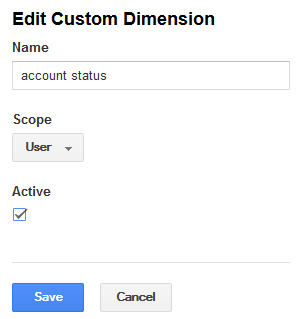
A “User” scoped Custom Dimension tracks account holders across visits to our site.
You may ask, “What if my lovely Account Holders clear their cookies or come on a different device?” For now, this will cause some of their sessions to look like anonymous visits. However, Google is doing its “1984 big brother” thing, and soon you’ll be able to track your account holders without using cookies.
Tracking Account Holders After They Are Logged Out
What do we call an account holder who has logged out? We call them a security-conscious account holder.
Fortunately, the “account status” dimension we set when they became an account holder, with “User” scope, will remember that they are an account holder for us, even if they log out.
When Should We Consider A Visitor An Account Holder?
For most of us, an account holder joins the ranks of the elite when they successfully complete the registration form. This form may ask for username and password. It may ask for name, email address and password. Ecommerce sites will typically store billing, shipping and credit card info for their account holders.
Many sites will also require verification of the email address, or confirmation of their registration. Account holders that don’t confirm their status are no better than anonymous visitors in this context.
One way to deal with this is to wait and mark an account holder as such when they first log in. This provides unequivocal evidence that they have applied for an account, verified their ownership, and made the effort to login at least once.
This means that we set the Custom Dimension “account status” to “has account” every time a visitor logs in. It may seem redundant to set the dimension every time they log in, but it doesn’t affect the data.
We certainly will be curious about those potential account holders who complete registration, but don’t verify or confirm their membership. So, we’ll use our “account status” dimension to commemorate the completion of the registration process, setting it to “unverified.” Then we can separately study visitors who have registered but have not confirmed their membership.
We can uncover issues with our “onboarding” this way.
Logged In Account Holders Are Poised For Action
We want to be able to track account holders’ login and logout behavior. Account holders that log in are poised to buy or take advantage of being a member of your site. They are extra special to us.
You can imagine your site as having two sets of pages: logged-in pages and logged-out pages. The URLs may not change when someone logs in. The content of the pages may be identical. However, from an analytics standpoint, logged in pages are serving a unique visitor, a visitor to which we want to pay special attention.
Logging in can be seen as a session-wide event. However, each session may be a mix of logged-in pages and logged-out pages. I recommend creating another Custom Dimension, named “login status,” with “Page” scope or “Hit” scope, in Universal Analytics. This would be set by some signal on the each page indicating that the visitor is logged in or logged out.
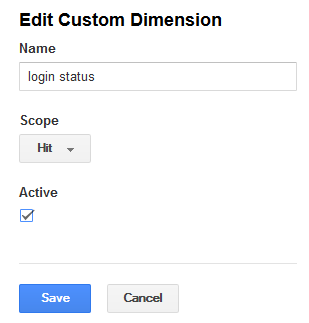
A “Hit” scoped Custom Dimension tracks if a visitor is logged in or not independently on any page.
This “Hit” scope lets us have sessions with a mix of logged in and logged out pages, depending on when the visitor takes these actions.
We will have to ask our development team to provide a signal on each page indicating if the visitor is logged in or logged out.
Using Tag Manager To Track Login & Logout Status
If we have a tag manager on our site, we can ask our developers to post a “datalayer” signal triggering our container to set our “login status” dimension. Each page will identify itself as a “Logged In” page or a “Logged Out” page. We will use this to set our “login status” dimension for each page the visitor comes to.
An Alternative Signal
There is one thing that is different for all logged-in pages on most sites. The “Log In” and “Log out” links. We’ve been able to identify “logged in pages” and “logged out pages” based on the message found in the header of every page of the site.

The Login and Logout links change based on user status for most sites.
Here’s a Google Tag Manager macro that returns the text of this login link.
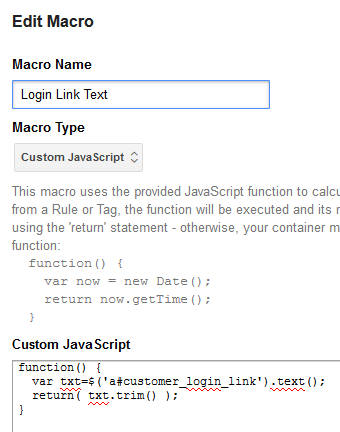
A Google Tag Manager macro that pulls the text of the login link.
This macro is specific to our whimsical Shopify site. Yours will be different.
If this macro returns “Log in,” we know the visitor isn’t logged in, and we can set our “login status” dimensions to “logged out.” If this macro returns “Log out,” we know we are on a “logged in” page and can set the dimension appropriately. More on setting dimensions below.
This macro is use by a Google Tag Manager rule triggered on pages where the visitor is signed in:
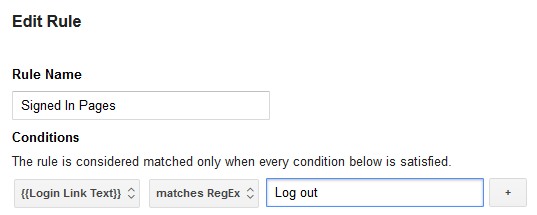
A Google Tag Manager rule allows us to place Google Analytics code on “Signed In Pages”
Then, a Google Tag Manager tag sets our custom variables for “Signed In Pages”:
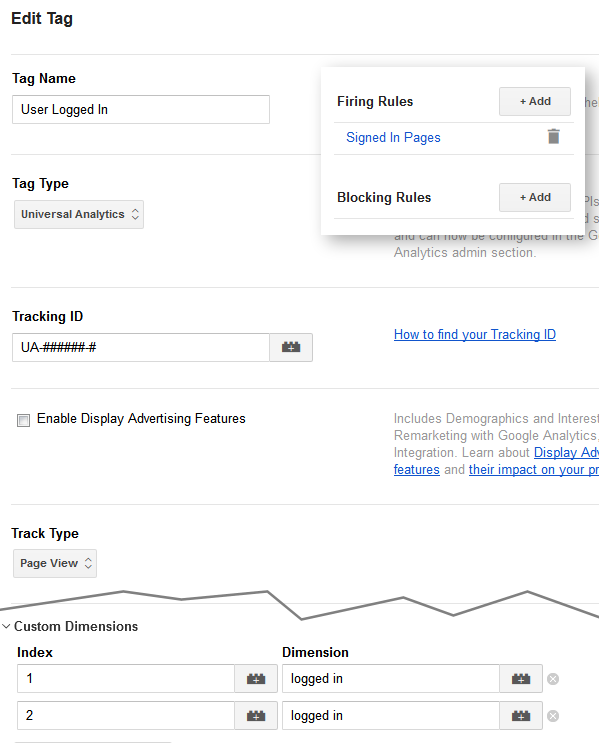
Now we can set custom dimensions when a visitor is on a page that shows them to be logged in.
We are big fans of working around the IT department when it makes sense. However, asking them to send specific datalayer signals is a more robust route.
What Metrics Are Interesting For Account Holders?
We will study many of the same metrics for account holders as we would for anonymous visitors.
For an ecommerce site, this would include revenue per visit, average order value, visits before purchase, time before purchase, abandonment rate, etc.
However, we are going to do a differential analysis to help us prioritize site changes. In Google Analytics, we will create an advanced segment for our Account Holders and see how they behave differently.
First, you should notice that account holders typically have a significantly higher conversion rate. They will also have a higher average order value in many cases.
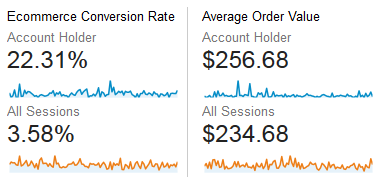
Account Holders are wonderful because the buy more and buy more often.
Account holders also tend to spend much more time and visit more pages on our sites. Aren’t they just wonderful?

Account holders may stay longer and shop more.
You may find that account holders have a lower revenue per session value. They may shop frequently just to browse. You should reward these visits with kind words and even discounts.
Which pages do account holders exit from most frequently? You can create a special segment and look at the Exit % by page.
Do account holders come in on the home page, or have they bookmarked their favorite category? You can see this through a landing page report.
Just watching Account Holders flow through your site can be eye-opening.

Here, Account Holders come through email and search, not by entering the site domain.
What if I told you most account holders came in through email? Would you step up your email efforts?
If I told you more account holders came in through search than directly, would you consider investing more in PPC?
You’ll do things differently in the service of these wonderful people we call account holders. And you’ll profit from it.
Should I Require An Account When Someone Purchases?
This is a question with philosophical and practical ramifications.
Philosophically, when we require a visitor to create an account before they purchase, we are begging them to let us love them. This is a bit stalkerish. Do we want people who were grudgingly forced to create an account to be counted among one of our most beloved visitors, our account holders?
If we look at it from the point of view of the buyer, it looks like this: You are asking me to create and somehow remember a password just so I can have the honor of buying from you. And what if I pick an easy to hack password? Doesn’t this make my credit card info vulnerable? And if you store this stuff for me, will you be as reliable as Target and Sony?
After all, I know why you want me to create an account. You want to continue marketing to me. You want to store my transactions and use this information to manipulate me.
And the next time I want to purchase, I’m likely to forget I created an account. You’ll tell me very politely that the account has already been created. So, I must now go through the “Forgot password” gauntlet of abandonment.
Do you really want someone with several hundred dollars of merchandise in their cart to have to complete two forms (the forgot password form and the reset password form); to wait for an email from you; and to be encouraged by you look at their inbox before they buy from you?
I didn’t think so.
Practically, we have seen that asking for an account will decrease your revenue per visit and increase your cart abandonment rates, and others have seen the same results.
What are we talking about here? Only two things separate visitors that purchase as a “Guest” and those that create an account:
- They have to create a password.
- They have to agree to our terms of service, which give us special permissions.
Buyers can still be required to give you an email address without creating an account. This is a convenience for them.
So, let’s all agree to get rid of the password and terms of service, and focus on the Receipt Page.
Turn Your Receipt Page Into A Thank You Page
If you want to encourage visitors to create an account, the best place to do so is on the receipt or thank you page, after the transaction is complete. Here, the onus is on you to convince your new customer to take one more action.
You must define the value of creating an account. Will you save their billing information? Will it make returns easier? Will they get a bonus gift or a discount on their next purchase?
You have the effect of “Liking” working in your favor. This is the tendency of humans to favor something more purely because they have chosen it. When you catch them in the glow of their choice, and before buyer’s remorse sets in, you have a good chance to turn them into an account holder as well as a customer.
Summary Of Tracking Tactics
On Account Creation
Set an Event commemorating the creation of the new account. We will also set the Custom Dimension “account status” to “unverified.”
Assuming our “account status” dimension is “dimension1,” we might use a call like this at account creation:
ga(‘send’, ‘event’, ‘account’, ‘account created’, {‘dimension1′:’unverified’});
On Login
We will send an Event to mark the login, and set our Custom Dimension “account status” to “has account” to signify that this visitor is now a bona fide account holder having completed a login. A separate signal will be sent on this page asking updating our “login status” Custom Dimension to “logged in.”
ga(‘set’, ‘dimension1’, ‘has account’);
ga(‘set’, ‘dimension2’, ‘logged in’);
ga(‘send’, ‘event’, ‘account’, ‘account login’);
On Logouts
When the visitor logs out, we set an Event to mark the logout, and our “login status” dimension is set to “logged out.”
ga(‘set’, ‘dimension2′:’logged out’);
ga(‘send’, ‘event’, ‘account’, ‘account logout’);
While we set dimension2 (login status) here, it will continue to be set on a page-by-page basis as well.
Account Holder Advanced Segment
Based on our definitions, we would create an advanced segment like this:
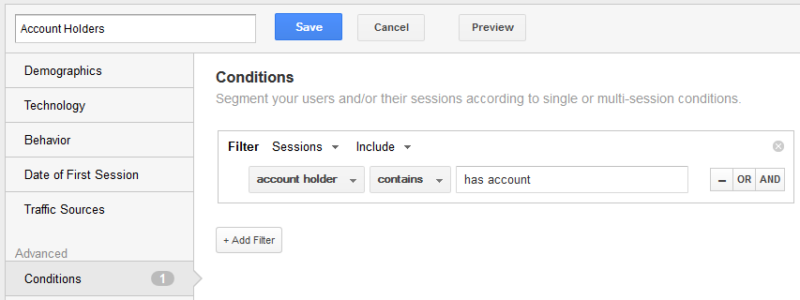
Creating the Account Holder Advanced Segment
You Are Now Free To Love Up Your Account Holders
Your Account Holders may behave differently from the examples I show here. That’s OK. Google Analytics will show you how account holders are unique so you can love them up when they visit.
Contributing authors are invited to create content for MarTech and are chosen for their expertise and contribution to the martech community. Our contributors work under the oversight of the editorial staff and contributions are checked for quality and relevance to our readers. MarTech is owned by Semrush. Contributor was not asked to make any direct or indirect mentions of Semrush. The opinions they express are their own.
Related stories
New on MarTech